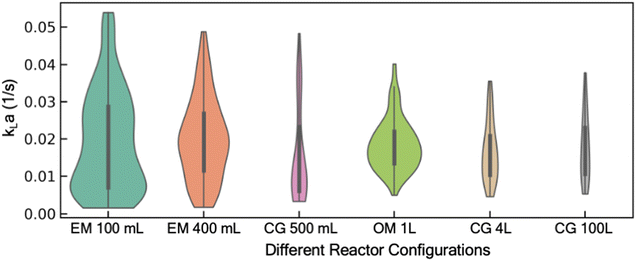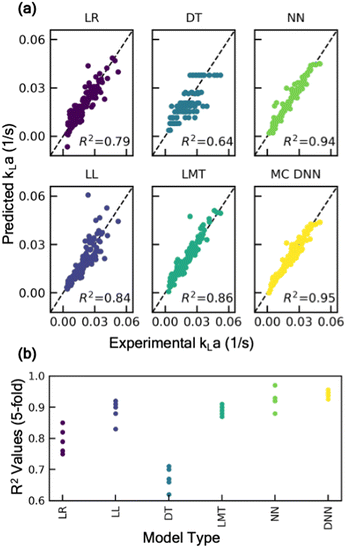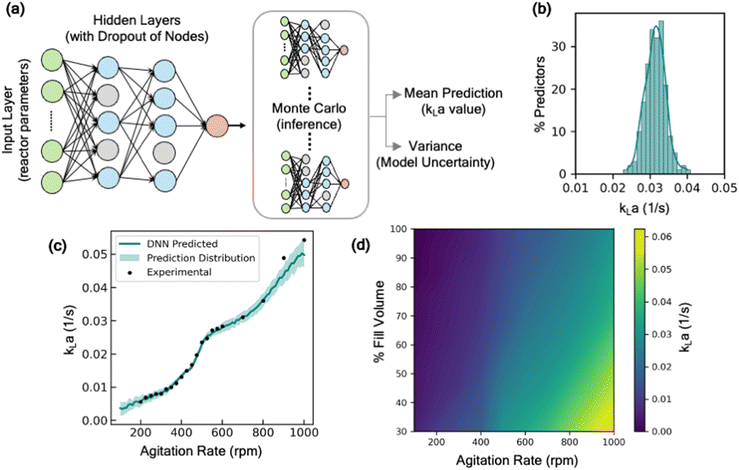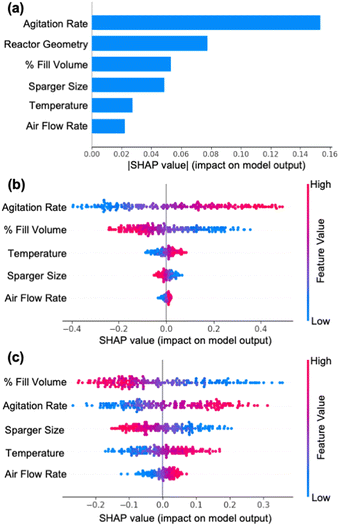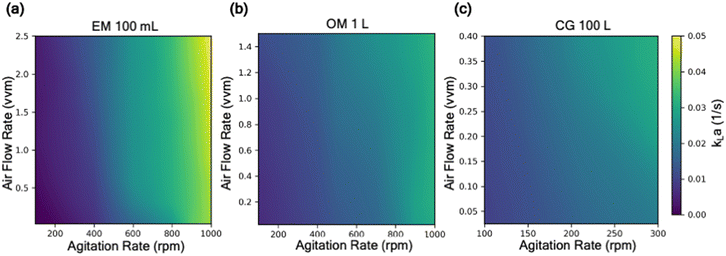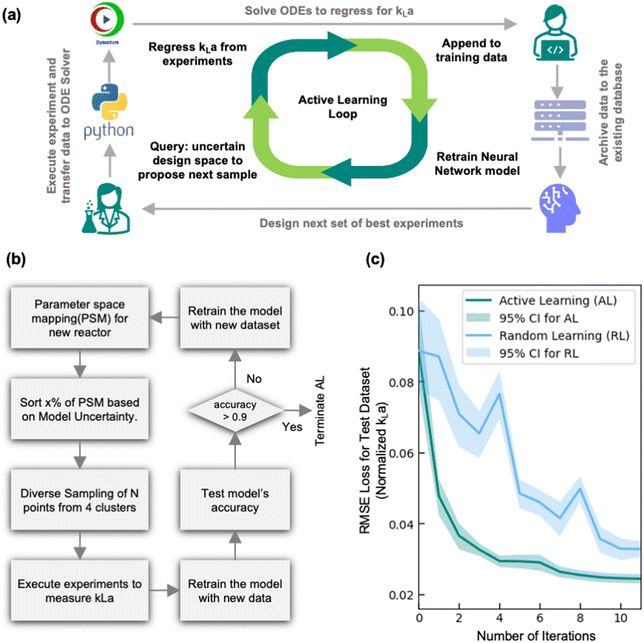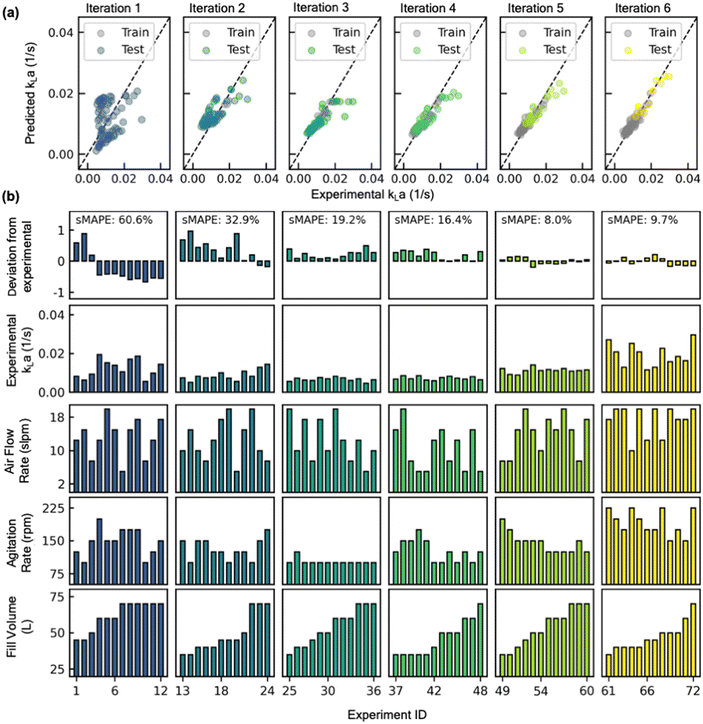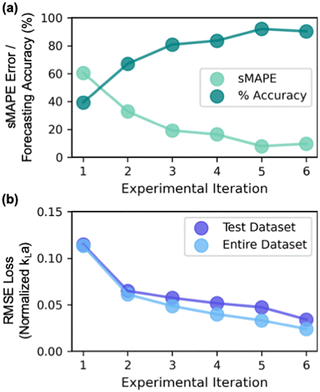 Open Access Article
Open Access ArticleActive learning enabled reactor characterization for mass transfer in aerobic oxidation reactions†
Ajit
Vikram
 *,
Keith A.
Mattern
* and
Shane T.
Grosser
*,
Keith A.
Mattern
* and
Shane T.
Grosser

Process Research and Development, Merck & Co., Inc., Rahway, New Jersey 07065, USA. E-mail: ajit.vikram@merck.com; keith.mattern@merck.com
First published on 18th November 2024
Abstract
Determination of mass transfer coefficients (kLa) plays a critical role in multiple biopharmaceutical operations ranging from aerobic oxidation reactions for small molecule process development to cell-culture based processes for large molecule process development. Accurate determination of kLa across different scales and reactor configurations is required to develop such processes in a robust and scalable manner. We report the development of a machine learning (ML) based model that accurately predicts kLa across different scales ranging for 100 mL to 100 L. We demonstrate that the ML model can further be used for predictive modeling, such as interpreting sensitivity and estimating impact of new process conditions. Furthermore, integrating the ability to estimate uncertainty in the model prediction, we developed a general framework for a diversified uncertainty-based active learning (AL) algorithm which iteratively recommends experiments based on information criteria and design-space exploration. The novel application of this framework enables automated mass transfer characterization of a previously unexplored reactor configuration. Specifically, we show that using this AL-guided iterative design of experiment led to progressive improvement in the model's forecasting accuracy, improving from 39% at the beginning of AL iterations to 90% at the completion of five AL iterations. Our results confirm that this AL framework offers an efficient closed-loop experimentation strategy that minimizes experimental burden required to accurately characterize mass transfer coefficients for aerobic oxidation processes.
Introduction
In the field of pharmaceutical development, biocatalysis has emerged as a powerful toolbox for greener synthesis of complex molecules.1,2 Biocatalytic processes offer several major benefits as an enabling technology, including their ability to mediate chemical transformations with high stereoselectivity, regioselectivity, and chemoselectivity.3 As a result, in recent years, the application of biocatalysis has led to several notable drug developments including islatravir,4,5 molnupiravir,6,7 and belzutifan.8 Among different classes of biocatalytic transformations, enzyme catalyzed oxidation reactions are of particular interest for selective formation of alcohols, aldehydes, ketones, and carboxylic acids. In many cases, such enzymatic chemical transformations require supply of molecular oxygen from compressed air as an oxidant for the reaction.9,10 Typically, these reactions are performed in a stirred batch reactor with continuous sparging of compressed air to the reaction volume. Stirred tank reactors facilitate gas–liquid oxygen transfer through the use of mechanical mixing to increase surface-to-volume ratio. The stirring creates turbulent mixing, enhancing the contact between the gas and liquid phase, while continuous sparging ensures a steady supply of air and thus maximizes the oxygen availability to the reactants. As a result, the rate of oxygen transfer significantly impacts the performance of the reaction because oxidative enzymes tend to consume oxygen faster than it can feasibly be replenished with traditional reactor designs. Moreover, the oxygen transfer rate (OTR) depends on several parameters that vary across scale, like reactor geometry, position and design of agitator and gas distribution systems, etc.11–14 Therefore, robust process development of aerobic oxidation reactions, and their successful transfer to commercial operation, requires accurate estimation of OTR in different reactor configurations across scales ranging from small scale laboratory reactors to large scale manufacturing reactors.In addition to small molecule biocatalytic processes such as the aerobic oxidation reactions, the principles of accurately estimating the OTR are equally critical in the large molecule production and biologics manufacturing. For instance, in cell culture-based production of therapeutic proteins such as monoclonal antibodies, OTR plays a vital role in maintaining the optimal cell growth and productivity.15 Accurate estimation and control of OTR is thus essential to prevent oxygen limitation, and maintain the metabolic balance required for high-yield production across scales ranging from lab-scale bioreactors to large-scale manufacturing of large molecules.
The product of the volumetric mass transfer coefficient (kLa) and the thermodynamic driving force (Csat − C) describes the overall OTR between gas and liquid phases.11 The thermodynamic driving force is represented as the difference between the bulk liquid oxygen concentration (C) and the theoretical saturation of oxygen (Csat) at the gas–liquid interface. The kinetic component of the OTR (kLa) thus becomes a vital scaling parameter, ensuring that the OTR is consistent across different reaction vessels and scales when held constant.12 Ensuring consistent kLa for the process is thus essential for all process optimization and characterization activities that otherwise influence process design or measure important process effects. However, kLa is highly sensitive to small changes in the process parameters, making its accurate determination notably difficult.11 Traditionally, extensive kLa characterization experiments are conducted across all scales to map experimental and operational variables to this key process parameter.9,16 Often, these require varying several different inputs (such as temperature, fill volume, air sparge rates, sparger type, and agitation) simultaneously to identify the optimal operating conditions, thus making the overall characterization process tedious and expensive in both time and resources.
Several empirical models have been previously reported for predicting kLa and correlating various process parameters such as agitation rate and volumetric flow rate of sparged air.17–19 While these models provide a foundation for qualitative understanding of kLa behavior in reactor vessels, they often fall short in accurately capturing the complex correlation between process parameters and the reactor configurations such as vessel geometry, number of baffles, size of spargers, etc. (more detailed discussion is provided later in the results section). Moreover, these empirical correlations are often not accurate in estimating kLa at small scale reactors (<200 mL that have drastically different reactor dimensions and geometry) where significant process development is conducted.11 These limitations underscore the need for developing a more efficient predictive model that can accurately predict kLa in various reactor configurations across different scales. Moreover, these challenges of accurately estimating the OTR in a process are not specific to development enzymatic oxidation reactions, but also apply to aerobic fermentation and cell culture processes for biopharmaceutical manufacturing as well.20,21
Advancements in machine learning (ML) techniques for building predictive models have been demonstrated as promising alternatives to empirical models in several different domains.22 ML models based on deep neural networks for instance can leverage vast amounts of process data to identify the intricate patterns and relationships that the empirical models lack.23–25 However, training ML algorithms often require large number of training datasets; application to mass transfer characterization would require execution of a large number of kLa characterization experiments across different reactor configurations. Recently, we reported an automated end-to-end workflow that automates the extraction of kLa coefficients under any given process conditions and reactor configuration.11 Leveraging this data-rich experimentation approach that combines process automation and a streamlined data workflow allowed us to execute a large number of kLa characterization experiments (>1000 across different scales) across a diverse set of reactor geometries and scales. These experimental kLa datasets in turn can enable the development of more accurate predictive ML-based models by serving as a diverse training dataset. The focus of our previously reported work11 was thus on developing a robust experimental workflow that enables experimental extraction of kLa values by executing automated experiments. The same workflow for kLa extraction has been leveraged in this work as well. However, the aim of this work is to (i) develop an accurate ML-based model that can predict kLa values under different conditions and reactor configuration by leveraging the existing experimental datasets, thus eliminating the need to execute additional kLa characterization experiments, and (ii) use this developed ML model to design the most informative set of kLa characterization experiments (executed using the same workflow as previously reported11) through an active learning framework.
Building ML-based predictive models on existing datasets, however, limits their application to only those reactor configurations that are included in the available training dataset, without risks of difficult extrapolation. To estimate kLa across the design space of a new reactor configuration thus necessitates inclusion of a significant number of additional training data on this previously unexplored reactor configuration, so that the model can accurately learn this expanded design space. This in turn requires extensive kLa characterization experiments, often using conventional design of experiments techniques to explore a large multi-dimensional design space.11 A more resource efficient approach would be to leverage the model that is trained on some existing reactor configurations to design optimal experiments in an iterative fashion until the model has adequately learned the design space of the new reactor configuration, according to some defined statistical target. This approach of using a ML model to design iterative experiments that are most informative for the model is known as active learning (AL).26
Integrating ML-based, predictive models with iterative experimental design using AL framework has been recently demonstrated as an efficient approach to reduce experimental burden in chemical space exploration, thus eliminating the need for exhaustive reaction screening.27,28 Several AL techniques using algorithms such as Bayesian optimization, ensemble neural networks, and genetic algorithms, have also been applied for optimization tasks in different domains such as organic chemistry, nanomaterials, etc. to optimize complex multidimensional processes while minimizing the number of experiments needed to achieve optimal conditions.29–31 Such approaches typically require two key components (1) a ML model that can accurately map the design space, and (2) a sampling strategy that can be used to design the next-best batch of experiments to achieve an optimal condition. Using AL to guide mass transfer characterization of a reactor can be considered analogous to these optimization problems, with the exception that the objective of the AL algorithm is to reduce prediction uncertainty in the multidimensional design space rather than identifying an optimal condition. Developing an AL framework thus offers a promising and yet unexplored approach for developing more autonomous and resource-efficient workflows for characterization, including reactor mass-transfer performance. Moreover, the workflow used to execute the experiments and then extract kLa values for model validation or active learning iterations is kept same as our previously reported work.
In this work, we developed and benchmarked various ML models to accurately learn the design space and predict kLa in different reactor configurations across scales. We demonstrate that interpretation of the developed ML model also enables critical insights into how the underlying parameters interact and impact the estimation of kLa values. Next, we developed a diversified uncertainty-based AL framework for efficient characterization of new, previously unexplored reactor configurations, while requiring a minimal number of experiments. By iteratively designing and selecting the most informative experiments, the AL framework enables an efficient closed-loop mass transfer characterization workflow, thus overcoming the need for an exhaustive design space exploration.
Results and discussion
Reactor database
With the aim to develop a predictive model for kLa, we first focus on the kLa database, its curation, and feature selection. A comprehensive mass transfer characterization to evaluate kLa under different operating conditions of a reactor often requires execution of many experimental trials, typically designed using full-factorial or mixed-factorial design of experiments. Given the wide range of possible operating conditions (temperature, fluid volume, air flow rate, and agitation rate) and reactor configurations (spargers, agitators, and their relative location inside the reactor), manual execution of these DoE studies are expensive in both time and resources. In response, we recently reported an end-to-end automated workflow for automated reactor control and data processing to regress kLa value from dissolved oxygen profiles.11 This methodology was used to collect kLa data from different combinations of operating conditions and reactor configurations. This database includes results from our historical kLa experiments in reactors ranging from 100 mL lab-scale reactors to 100 L kilo scale reactors (Fig. 1).11 It should be noted that in this work, kLa is reported in s−1 units rather than more commonly reported h−1 units. The discrepancy in the preferred unit for reporting kLa stems from the difference in the domain. Generally, large molecule bioprocess-focused literature reports kLa in h−1 units in contrast to the small molecule focused literature that tends to report kLa values in s−1 units.32,33 Moreover, the order of magnitude of the kLa range reported for large molecule processes (0.1–100 h−1) is similar to the range shown in Fig. 1 (0.005–0.05 s−1i.e., 18–180 h−1) for the reactor configurations used in this work.15 We used this database to first train a predictive model that can learn the function to map the input features (different operating conditions and reactor configurations) to the output feature (experimentally estimated kLa). The input features are represented by 5 continuous input parameters (sparger size, fill volume of the reactor vessel, temperature, agitation rate, and VVM: volumetric flow rate of air per reactor volume), and 1 categorical input parameter (reactor configuration). Reactor configuration features such as the specific reactor geometry, shape of the agitator blade, the number of baffles (including in situ process probes such as temperature, pH, and dissolved oxygen probes) and their relative position in the reactor are all combined in this single categorical feature for the model. Although each of these features for the reactor configuration can be treated as a separate input to the model, that would require a significantly larger and more diverse dataset for the model to learn how each of these individual feature impacts kLa. Moreover, the accurate representation of complex geometric features such as shape of the agitator blade, or specific three-dimensional representation of the reactor design offers additional challenge. Hence, in this work, we combined all features related to the reactor configuration into a single categorical feature for simplicity. The one-hot encoding technique is used to represent this categorical feature as a numerical input to the model. The trained model can then be used to estimate kLa under new and previously unexplored process conditions.Model development and deployment
The rationale behind the selection of appropriate model architecture to build a predictive model often depends on several factors including the type of dataset, computational cost, and the desired outcome from the model. For instance, models with high interpretability such as linear models or decision-trees, offer the benefit of representing the input and output features through relatively simple mathematical relationship, thus making it easier to understand how each input feature influences the outcome. However, due to their inherent simplicity and structural limitations, such models may not capture complex parameter interactions. Alternatively, more complex, and less interpretable models like deep neural networks offer the advantage of potentially achieving higher accuracy, as well as the ability to estimate model prediction uncertainty by incorporating probabilistic models. To identify an appropriate model architecture, we explored multiple different class of ML models: linear regression models, tree-based models, and neural network-based models. Fig. 2 shows the performance of these models on the test dataset. For each of these models, 20% of the dataset was withheld for testing the predictive performance of the model and the remaining was used to train the model and optimize hyperparameters. More details on the model training methodology are discussed in the supplementary information (section S1†). Our comparative analysis elucidates the nuanced trade-off between model complexity and interpretability. Linear models, for instance, are expected to behave similar to empirical models for estimating kLa, and thus offer a simpler and more interpretable approach to understand the impact of different parameters on kLa values. Here, we explored two types of linear models: (i) standard linear regression with no data transformations, and (ii) log-transformed linear models, where log transformation is applied to the data for linearity and normality. The details of the data transformation and model training are discussed in the supplementary information (section S1†). Despite their simplicity, linear models yielded limited accuracy on the test dataset, with mean R2 values in the range of 0.79 to 0.84, thus failing to capture the sensitivity of kLa to minor changes in the operating conditions (Fig. 2). Additionally, a linear model tree (LMT) design that combines linear regression with decision tree (DT)-based architecture, offers slight improvement in capturing the complex relation between the input variables. LMT can be seen as a hybrid approach where some interpretability can be maintained due to linear regression at the tree branches and splits while also letting the model learn the complex hierarchical relation between different configurations. However, this also comes at the cost of model interpretability due to the multitude of decision rules involved in making predictions. In contrast, Monte Carlo dropout neural networks (MC-DNN), a variation of deep neural networks (Fig. 3a), yielded high prediction accuracy with R2 values up to 0.95 on the test data. Although complete interpretability is a longstanding challenge for deep neural networks, our benchmarking study suggests that it significantly outperforms other models for predicting kLa, likely due to their ability to learn complex hierarchical representations of the data through multiple layers of interconnected neurons. MC-DNN offers two additional major advantages over standard neural networks: (1) during the training of the model, it randomly ‘drops out’ a fraction of neurons in the hidden layer (Fig. 3a and b), thus offering an inexpensive regularization technique to prevent the model from overfitting output variance to a specific subset of nodes; and (2) during the inference or prediction from the model, randomized dropout masks are applied to the hidden layer to give a probabilistic distribution of the predicted value from multiple ensembles of the trained model, thus providing an estimate for uncertainty in model's prediction (Fig. 3b), rather than a single prediction value that is provided by standard neural network models.34Moreover, the predictions are also accompanied with an estimate of prediction certainty. For instance, the model has lower prediction certainty in the design space regions where the training data is scarce (low kLa region i.e., at lower agitation rate), and higher certainty in the design space region where historical data used for training was present in abundance (Fig. 3c). The estimation of the model uncertainty along with the prediction allows a more-informed decision for determining the appropriate operating ranges for the desired oxidation process.
Next we demonstrate that these predictive ML tools can also be easily democratized through broad deployment using an intuitive web application-based interface,36 thus empowering scientists within the organization to access and utilize the trained ML model without requiring programming or data science expertise. All complex data manipulations are kept in the back end of the interface with the user only exposed to the necessary inputs to allow them to explore predicted kLa values with calculated model uncertainty. The details of the web app deployment for predicting kLa are shown and discussed in ESI† (section S2). This tool serves two primary use cases: (i) enabling scientists to estimate predicted kLa under specific operating conditions, and (ii) allowing them to explore the design space to find operating conditions that achieve the desired kLa for their processes. By providing a simple to use graphical user interface, this web app streamlines workflow and facilitates broader adoption of such technologies.
Active learning
The developed MC-DNN model is highly accurate when predicting kLa in reactors with extensive prior characterization but is not able to extrapolate beyond the design space to make predictions in new reactor geometries/configurations. To accurately predict kLa in this extrapolation region thus requires retraining the model with additional training data specific to this new reactor configuration. Hence, we next explored the ability of using an active learning (AL) framework in combination with the developed MC-DNN model to efficiently characterize a new, previously unexplored reactor configuration. The AL framework offers an efficient experimental design strategy that utilizes ML models to iteratively design the next set of best experiments to perform by leveraging and assessing the uncertainty in the model's prediction. In our case, by using the MC-DNN model, we can estimate the model's uncertainty across the entire parameter space then sample conditions that exhibit the highest uncertainty in terms of relative width of the prediction band from their mean value. These selected experiments are then conducted to evaluate kLa at these conditions, and the results are incorporated in the training dataset. The model is then retrained with the updated training dataset and the process is repeated. This iterative process (summarized in Fig. 6a) of querying the design space to design experiments, executing the experiments, appending the data, and retraining the model continues until the model accurately characterizes the new reactor configuration based on a pre-determined threshold or criteria. For instance, the stopping criteria in this work was based on model reaching 90% forecasting accuracy (i.e., how well can the model predict the outcome of the experiments proposed in the current iteration). Alternate stopping criteria such as those that are based on improvement in overall model certainty across the design space can also be used depending on the application and objective of the AL-guided experiments. This AL framework thus enables an automated, closed-loop kLa characterization workflow to fully characterize a new and previously uncharacterized reactor configuration while minimizing the number of required experimental trials.One of the most critical aspects of this AL workflow is the choice of sampling strategy, i.e., how does the model decide which experiment to run next. In practice, rather than executing single experiment at a time, it is generally more resource-efficient to either execute multiple experiments in parallel or execute multiple experiments in a sequential fashion by leveraging laboratory automation tools. Hence, the AL sampling strategy explored in this work is designed to propose a batch of experimental conditions, rather than a single experimental condition. A variety of different batch sampling strategies have been used for different AL applications.27,37,38 One of the most common is uncertainty-based sampling. In this approach, the AL algorithm simply queries the condition with the highest uncertainty. This strategy is widely used due to its simplicity of implementation. However, one of the major drawbacks of this strategy is that if a specific region in the design space has very high uncertainty (such as low air flow rate and agitation rate), either due to high noise in the experimental data in that region, or high noise in the data processing protocols (such as regression of dissolved oxygen profile), then the algorithm may sample iteratively and exclusively from a specific region of the design space. While this strategy may improve accuracy in this specific region, the sampled conditions in a batch of experiments are very similar to each other and thus add limited new knowledge to the overall model. This can lead to large number of experimental iterations before the algorithm starts to explore a new region of lower uncertainty. This challenge is analogous to what is observed in the field of algorithmic process optimization using Bayesian approach, where the algorithm must balance between exploitation of promising performance with the exploration of areas of uncertainty to avoid oversampling a globally inferior local optimal solution.39 To mitigate this challenge, we leveraged a diversified uncertainty-based sampling strategy for the AL algorithm, which have been demonstrated to be more generalizable and efficient compared to sampling based on uncertainty only.38 This novel application highlights a different focus from traditional applications in which the goal of the AL framework proposed in this work is not to find optimal conditions, but instead to accurately map the entirety of a specified design space. Fig. 6b shows the flowchart of the AL framework using diversified uncertainty sampling. Specifically, when the parameter space is mapped based on the model's predictions, the next set of experimental conditions are sampled by considering both the geometric diversity of the points in the experimental batch as well as the prediction uncertainty. First, the parameter space map (PSM) prediction is sorted based on uncertainty, and then a fraction of the most uncertain points is selected (where the fraction can be adjusted as a hyperparameter) and clustered into 4 clusters using the k-means clustering algorithm. Followed by this, samples with specified batch size (N) are drawn equally from each cluster. This approach of diversified uncertainty sampling thus allows us to design diverse batches of experimental conditions that balance broad design space exploration with investigation of areas with high prediction uncertainty.
where ypred,i and yexpet,i are the predicted and experimental kLa values for each sample in the AL iteration, and n is the number of samples in the AL iteration.
Starting with a sMAPE value of 60.6% (i.e., forecasting accuracy of 39.4%) at the beginning of the AL iteration, the model progressively improves after each AL iteration, yielding a sMAPE value of 9.7% (i.e., forecasting accuracy of 90.3%) at the completion of the AL iteration (Fig. 8a).
The improvement in model's performance can also be evaluated and confirmed through the retrospective analysis of the model. At the beginning of each iterative cycle, the model trained on all prior experiments was stored. At the conclusion of all six iterations, the performance of the model from each iteration was assessed in terms of prediction parity (Fig. 7a) on test dataset (i.e., all experimental data that is collected in the subsequent iterations) and the entire complete dataset collected throughout the six iterations. As evident, the root mean squared error (RMSE) value between experimental kLa and predicted kLa on test dataset progressively improves from 0.11 at the beginning of AL to 0.03 at the conclusion of AL iterations (Fig. 8b). Through strategic selection and incorporation of the new experimental conditions into the training process, the model continuously refines its estimate of the parameter interactions and the underlying relations between different process conditions across the entirety of the reactor design space. Moreover, the progressive improvement in the model's prediction underscores the effectiveness of active learning in designing optimal experiments that could be most informative for building a predictive model in a previously unexplored design space.
Conclusions
In this work, we demonstrate a generalizable active learning framework as a promising tool for efficiently characterizing mass transfer coefficients (kLa) in reactors by iteratively selecting and proposing experiments that are most informative for the model. This was accomplished through first developing and benchmarking different ML models in the context of accurately predicting kLa across scale and then integrating the developed model with an active learning framework. Our benchmarking study of different ML models suggests that Monte-Carlo dropout neural networks (MC-DNN) outperform the other models investigated. Moreover, using SHAP analysis for interpretation of the MC-DNN model, we showed that sensitivity and impact of different process conditions (such as agitation rate, fill volume, and air sparge) vary significantly across different reactor configuration and scales, thus highlighting the importance of replacing existing generalized empirical models with machine learning-based models for estimating kLa. The MC-DNN model also enabled estimation of uncertainty in model prediction, that allowed us to integrate it with a diversified-sampling based AL framework. Our results show that the diversified uncertainty-based AL approach enables design of diverse and informative experiments that yields a progressive improvement in the overall accuracy of the model while minimizing the number of experiments required. After completion of five iterative experiments, the AL algorithm allowed us to fully characterize a new and previously unexplored reactor configuration. This is evident from the observed improvement in the model's forecasting accuracy from 39% at the beginning to 90% at the conclusion of AL-guided experiments. These results demonstrate that the AL-guided experimentation strategy presented in this work offers a promising workflow to reduce the experimental burden of conducting exhaustive experimentation for characterizing kLa in reactors.The active learning framework of iteratively exploring the design space (i.e., querying the design space to propose experiments, executing the experiments, appending the experimental data, and then retraining the model with the new information until the model accurately learns the design space) offers a promising path forward towards developing fully autonomous platforms for process characterization at large. Future research in this area should focus on integrating this active learning approach with process and laboratory automation alongside streamlined data pipelines to further reduce the manual burden of characterizing new reactor configurations. Although, the work reported here utilized water (with no added reagents) as the choice of media for kLa characterization, the generalizable framework presented here can be further extended to develop models that also account for the impact of added reagents, such as antifoam or reaction media, on the predicted kLa values and the resulting oxygen transfer rates. For example, the amount of antifoam added (a continuous parameter) and the type of reaction media used (a categorical parameter) can be incorporated as additional input features to the model. This would enable the model to learn the correlation between kLa values and the amount of antifoam and cell media. In addition, the overall workflow presented in this work can be extended and adopted for a wide range of applications, where the objective is to efficiently design the most informative experiments to build predictive machine learning models for a process. Further implementation and adoption of such technologies across different aspects of drug process development will facilitate acceleration of timelines with the most effective use of resources, while also maximizing valuable process insights.
Data availability
The data related to the hyperparameters of all the machine learning models developed in this article has been included as part of the ESI.† Additional data related to the mass transfer characterization are available upon request from the authors.Author contributions
A. V. (conceptualization, methodology, investigation, formal analysis, and writing – original draft), K. A. M. (conceptualization, investigation, supervision, writing – review & editing), S. T. G. (conceptualization, supervision, project administration, and writing – review & editing).Conflicts of interest
There are no conflicts to declare.Acknowledgements
The authors would like to thank Kevin Stone for reviewing the manuscript.References
- N. N. Zhang, P. D. de Maria, S. Kara and A. Salomone, Catalysts, 2024, 14, 84 CrossRef CAS.
- A. Fryszkowska and P. N. Devine, Curr. Opin. Chem. Biol., 2020, 55, 151–160 CrossRef CAS PubMed.
- C. K. Winkler, J. H. Schrittwieser and W. Kroutil, ACS Cent. Sci., 2021, 7, 55–71 CrossRef CAS PubMed.
- H. C. Johnson, S. G. Zhang, A. Fryszkowska, S. Ruccolo, S. A. Robaire, A. Klapars, N. R. Patel, A. M. Whittaker, M. A. Huffman and N. A. Strotman, Org. Biomol. Chem., 2021, 19, 1620–1625 RSC.
- M. A. Huffman, A. Fryszkowska, O. Alvizo, M. Borra-Garske, K. R. Campos, K. A. Canada, P. N. Devine, D. Duan, J. H. Forstater, S. T. Grosser, H. M. Halsey, G. J. Hughes, J. Jo, L. A. Joyce, J. N. Kolev, J. Liang, K. M. Maloney, B. F. Mann, N. M. Marshall, M. McLaughlin, J. C. Moore, G. S. Murphy, C. C. Nawrat, J. Nazor, S. Novick, N. R. Patel, A. Rodriguez-Granillo, S. A. Robaire, E. C. Sherer, M. D. Truppo, A. M. Whittaker, D. Verma, L. Xiao, Y. J. Xu and H. Yang, Science, 2019, 366, 1255–1259 CrossRef CAS.
- J. A. McIntosh, T. Benkovics, S. M. Silverman, M. A. Huffman, J. Kong, P. E. Maligres, T. Itoh, H. Yang, D. Verma, W. L. Pan, H. I. Ho, J. Vroom, A. M. Knight, J. A. Hurtak, A. Klapars, A. Fryszkowska, W. J. Morris, N. A. Strotman, G. S. Murphy, K. M. Maloney and P. S. Fier, ACS Cent. Sci., 2021, 7, 1980–1985 CrossRef CAS PubMed.
- W. Holman, W. Holman, S. McIntosh, W. Painter, G. Painter, J. Bush and O. Cohen, Trials, 2021, 22, 561 CrossRef CAS PubMed.
- D. A. DiRocco, Y. L. Zhong, D. N. Le, S. D. McCann, J. C. Hethcox, J. Kim, J. N. Kolev, B. Kosjek, S. M. Dalby, J. P. Mcmullen, R. Gangam and W. J. Morris, Org. Process Res. Dev., 2024, 28, 404–412 CrossRef CAS.
- J. Kim, V. C. R. Zhang, K. Abe, Y. Z. Qin, D. A. Dirocco, J. P. McMullen, A. L. X. D. Sun, R. Gangam, M. Chow, A. Pitts-McCoy and A. S. Malkani, Org. Process Res. Dev., 2024, 28, 422–431 CrossRef CAS.
- W. L. Cheung-Lee, J. N. Kolev, J. A. Mcintosh, A. A. Gil, W. L. Pan, L. Xiao, J. E. Velasquez, R. Gangam, M. S. Winston, S. S. Li, K. Abe, E. Alwedi, Z. E. X. Dance, H. Y. Fan, K. Hiraga, J. Kim, B. Kosjek, D. N. Le, N. S. Marzijarani, K. Mattern, J. P. Mcmullen, K. Narsimhan, A. Vikram, W. Wang, J. X. Yan, R. S. Yang, V. Zhang, W. Zhong, D. A. Dirocco, W. J. Morris, G. S. Murphy and K. M. Maloney, Angew. Chem., 2024, 63, e202316133 CrossRef CAS PubMed.
- K. Mattern and S. T. Grosser, Org. Process Res. Dev., 2023, 27, 1992–2009 CrossRef CAS.
- L. K. Zhu, B. Xu, X. Y. Wu, J. G. Lei, D. L. Hacker, X. Liang and F. M. Wurm, 3 Biotech, 2020, 10, 397 CrossRef PubMed.
- M. Aroniada, S. Maina, A. Koutinas and I. K. Kookos, Biochem. Eng. J., 2020, 155, 107458 CrossRef CAS.
- W. Klöckner, R. Gacem, T. Anderlei, N. Raven, S. Schillberg, C. Lattermann and J. Büchs, J. Biol. Eng., 2013, 7, 28 CrossRef PubMed.
- S. Xu, L. Hoshan, R. B. Jiang, B. Gupta, E. Brodean, K. O'Neill, T. C. Seamans, J. Bowers and H. Chen, Biotechnol. Prog., 2017, 33, 1146–1159 CrossRef CAS.
- Y. Z. Qin, K. A. Mattern, V. C. R. Zhang, K. Abe, J. Kim, M. Zheng, R. Gangam, A. Kalinin, J. N. Kolev, S. Axnanda, Z. E. X. Dance, U. Ayesa, Y. N. Ji, S. T. Grosser, E. Appiah-Amponsah and J. P. McMullen, Org. Process Res. Dev., 2024, 28, 432–440 CrossRef CAS.
- M. Nocentini, Chem. Eng. Res. Des., 1990, 68, 287–294 CAS.
- R. Kayser, Prog. Water Technol., 1979, 11, 23–36 CAS.
- I. T. M. Hassan and C. W. Robinson, Biotechnol. Bioeng., 1977, 19, 661–682 CrossRef CAS.
- S. Schaepe, A. Kuprijanov, C. Sieblist, M. Jenzsch, R. Simutis and A. Lübbert, J. Biotechnol., 2013, 168, 576–583 CrossRef CAS.
- S. Goldrick, K. Lee, C. Spencer, W. Holmes, M. Kuiper, R. Turner and S. S. Farid, Biotechnol. J., 2018, 13, e1700607 CrossRef.
- T. Y. Zhao, S. C. Liu, J. Xu, H. L. He, D. Wang, R. Horton and G. Liu, Agric. For. Meteorol., 2022, 323, 109080 CrossRef.
- T. T. Khuat, R. Bassett, E. Otte, A. Grevis-James and B. Gabrys, Comput. Chem. Eng., 2024, 182, 108585 CrossRef CAS.
- G. N. Huang, Y. N. Guo, Y. Chen and Z. W. Nie, Materials, 2023, 16, 5977 CrossRef CAS PubMed.
- Y. D. Liu, Q. Yang, Y. Li, L. Zhang and S. Z. Luo, Youji Huaxue, 2020, 40, 3812–3827 CrossRef CAS.
- D. Cohn, L. Atlas and R. Ladner, Mach. Learn., 1994, 15, 201–221 Search PubMed.
- N. S. Eyke, W. H. Green and K. F. Jensen, React. Chem. Eng., 2020, 5, 1963–1972 RSC.
- A. Pomberger, A. A. P. McCarthy, A. Khan, S. Sung, C. J. Taylor, M. J. Gaunt, L. Colwell, D. Walz and A. A. Lapkin, React. Chem. Eng., 2022, 7, 1368–1379 RSC.
- M. Christensen, L. P. E. Yunker, F. Adedeji, F. Hase, L. M. Roch, T. Gensch, G. Dos Passos Gomes, T. Zepel, M. S. Sigman, A. Aspuru-Guzik and J. E. Hein, Commun. Chem., 2021, 4, 112 CrossRef PubMed.
- A. Vikram, K. Brudnak, A. Zahid, M. Shim and P. J. A. Kenis, Nanoscale, 2021, 13, 17028–17039 RSC.
- R. J. Hickman, M. Aldeghi, F. Häse and A. Aspuru-Guzik, Digital Discovery, 2022, 1, 732–744 RSC.
- Z. D. Chen and J. J. J. Chen, Mixing and Crystallization, Springer, 2000, pp. 43– 56 Search PubMed.
- W. Tran, T. C. Seamans and J. S. Bowers, Biotechnol. Prog., 2023, 39, e3382 CrossRef CAS PubMed.
- Y. Gal and Z. Ghahramani, Proc. Int. Conf. Mach. Learn., 2016, 48, 1050–1059 Search PubMed.
- K. Van't Riet, Ind. Eng. Chem. Process Des. Dev., 1979, 18, 357–364 CrossRef.
- J. A. G. Torres, S. H. Lau, P. Anchuri, J. M. Stevens, A. G. Doyle, J. E. Tabora, J. Li, A. Borovika and R. P. Adams, J. Am. Chem. Soc., 2022, 144, 19999–20007 CrossRef CAS PubMed.
- K. Y. Zhang, B. Y. Qian, J. S. Wei, C. C. Yin, S. L. Cao, X. Y. Li, Y. J. Cao and Q. H. Zheng, Egypt. Inform. J., 2023, 24, 100412 CrossRef.
- J. T. Ash, C. Zhang, A. Krishnamurthy, J. Langford and A. Agarwal, arXiv, 2019, preprint, arXiv:1906.03671, DOI:10.48550/arXiv.1906.03671.
- B. Shahriari, K. Swersky, Z. Y. Wang, R. P. Adams and N. de Freitas, Proc. IEEE, 2016, 104, 148–175 Search PubMed.
- Y. Sheng, Y. S. Wu, J. Yang, W. C. Lu, P. Villars and W. Q. Zhang, npj Comput. Mater., 2020, 6, 1–7 CrossRef.
- N. Jiscoot, E. A. Uslamin and E. A. Pidko, Digital Discovery, 2023, 2, 994–1005 RSC.
Footnote |
| † Electronic supplementary information (ESI) available: Additional details on model training, data transformations, model deployment, and model interpretation. See DOI: https://doi.org/10.1039/d4re00410h |
| This journal is © The Royal Society of Chemistry 2025 |

